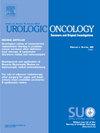Do differences in secondary treatment explain mortality impact of prostate cancer screening? – A randomized screening trial
IF 2.4
3区 医学
Q3 ONCOLOGY
Urologic Oncology-seminars and Original Investigations
Pub Date : 2025-04-10
DOI:10.1016/j.urolonc.2025.02.023
引用次数: 0
Abstract
Background
The European Randomized study of screening for prostate cancer (ERSPC) demonstrated a reduction in prostate cancer (PC) mortality via PSA-based screening. We evaluated whether treatments for castration resistant PC vary between the trial arms within the Finnish section (FinRSPC) of the ERSPC.
Methods
Clinical data were collected from medical records and national health care databases for all men diagnosed with PC and starting androgen deprivation therapy (ADT) during 1996–2015 at Tampere University Hospital. We evaluated frequencies and durations of treatments for castration resistant PC. Cox regression was used to assess time from ADT initiation to castration resistant PC treatment.
Results
In total, 62 (14.2%) and 116 (15.9%) received at least % cycle of treatment for castration resistant PC in the screening and control-arm, respectively. There were no statistically significant differences in distribution of treatments for castration resistant PC between the study arms at any treatment lines (P-values over 0.05 for first, second and third & later lines of treatment). No difference was found in time to initiation of treatment for castration resistant PC after ADT. (HR: 1.00; 95% [CI], 0.78-1.39; P = 0.998).
Conclusions
Although limited by small sample size and a single-center scope, our findings suggest the mortality result of the FinRSPC is not attributable to differing treatment for castration-resistant PC between the trial arms
二次治疗的差异能否解释前列腺癌筛查对死亡率的影响?-随机筛选试验
欧洲前列腺癌筛查随机研究(ERSPC)表明,通过基于psa的筛查可以降低前列腺癌(PC)死亡率。我们评估了在ERSPC芬兰部分(FinRSPC)的试验组中,去势抵抗性PC的治疗方法是否存在差异。方法收集1996-2015年坦佩雷大学医院所有诊断为PC并开始雄激素剥夺治疗(ADT)的男性患者的病历和国家卫生保健数据库的临床资料。我们评估了去势抵抗性PC的治疗频率和持续时间。使用Cox回归评估从ADT开始到抗去势PC治疗的时间。结果筛查组和对照组分别有62例(14.2%)和116例(15.9%)接受了至少%周期的去势抵抗性PC治疗。在任何治疗线上,研究组间去势抵抗性PC的治疗分布均无统计学显著差异(第一、第二和第三治疗组的p值均大于0.05;以后的治疗)。ADT后抗去势PC开始治疗的时间无差异。(人力资源:1.00;95% [ci], 0.78-1.39; = 0.998页)。结论:尽管受限于小样本量和单中心范围,我们的研究结果表明,FinRSPC的死亡率结果不能归因于试验组之间对去势抵抗性PC的不同治疗
本文章由计算机程序翻译,如有差异,请以英文原文为准。
求助全文
约1分钟内获得全文
求助全文
来源期刊
CiteScore
4.80
自引率
3.70%
发文量
297
审稿时长
7.6 weeks
期刊介绍:
Urologic Oncology: Seminars and Original Investigations is the official journal of the Society of Urologic Oncology. The journal publishes practical, timely, and relevant clinical and basic science research articles which address any aspect of urologic oncology. Each issue comprises original research, news and topics, survey articles providing short commentaries on other important articles in the urologic oncology literature, and reviews including an in-depth Seminar examining a specific clinical dilemma. The journal periodically publishes supplement issues devoted to areas of current interest to the urologic oncology community. Articles published are of interest to researchers and the clinicians involved in the practice of urologic oncology including urologists, oncologists, and radiologists.

 求助内容:
求助内容: 应助结果提醒方式:
应助结果提醒方式:


